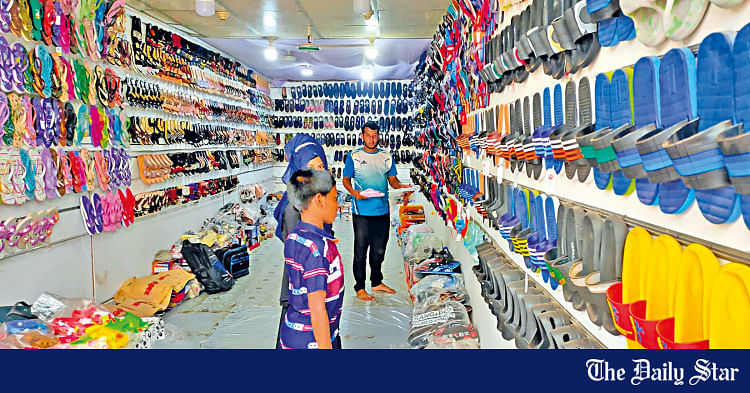An economic corridor that quietly fuels growth
At the turn of the millennium, travelling by road between Sylhet and Dhaka felt akin to a trek across rugged terrain. One would have to awkwardly traverse bumps along narrow and winding paths for upwards of 10 hours to make the trip either way.
Those days are now gone.
Not only has the travel time between the capital and the northeast division bordering India's Seven Sisters come down to just a fraction, but the landscape, farmlands, haors and rural settlements have evolved.
Factories, churning out products for domestic and international markets, now line the sides of the nearly 200-kilometre highway, a scene many could scarcely imagine in the early nineties.
Furthermore, several areas of the Habiganj district, including Shayestaganj, Chunarughat, Bahubal and Nabiganj, have become hotspots for industrial units.
In Madhabpur, located near Habiganhj's periphery, the hush of the morning quiet is now broken by the busy footsteps of workers from nearby localities.
"The town has transformed into a bustling industrial hub, with activity throughout the day. Thousands of people are employed across various factories, contributing to the area's vibrant atmosphere," said Sadekul Islam, a local.
Islam, who also works at a factory in the area, added that development had taken place gradually over the past two decades, but recounted that it all started with the renovation of the Dhaka-Sylhet Highway in 2003.
After it was revamped, entrepreneurs flocked to acquire land, which was available for affordable prices, leading to a surge in factory establishments.
Big corporations bought thousands of acres and, over the past one and a half decades, light, medium, and heavy industries have proliferated.
The availability of gas in Habiganj, which produces about 60 percent of the country's supply of the natural resource, played a key role in the region's evolution into a commercial hub.
"Once a neglected area with barren land and limited agricultural potential, it had few employment opportunities," Miftaul Hossain Chawdhury, a trader from Madhabpur, said as testified to the changes he had witnessed.
Recognising this, Abul Maal Abdul Muhith, during his tenure as Bangladesh's finance minister from 2009 to 2019, encouraged entrepreneurs to set up factories in the region by offering state gas connections, he said.
Siddiq Mia, a 55-year-old resident of the Shahpur area of Habiganj, added that the land was fallow and prone to flooding. Since cultivation was inconsistent, land was inexpensive, he said.
This medley of affordable land, availability of gas, and the region's proximity to Dhaka proved to be a winning combination, attracting entrepreneurs and paving the way to significant industrial growth.
The industrial boom transformed the local economy and has created at least 200,000 jobs.
"The highway has become a growth corridor," said Eleash Mridha, managing director of Pran Group, a unit of Pran-RFL Group.
He also credited former finance minister Muhith, saying that when the Awami League government stopped providing new gas connections through state gas companies, the Jalalabad Gas Transmission and Distribution System Ltd in Sylhet was kept out of the purview of that order thanks to the minister's lobbying.
"Gas connections were available from the state company and this provided the impetus for industrialists to establish factories in the region," he said.
"Factories were first established in the Shayestaganj area of Habiganj. Over time, more popped up. Today, industrial units have spread all the way up to Brahmanbaria. It is now expanding towards the Bhairab upazila of Kishoreganj."
Pran-RFL Group, one of the country's largest conglomerates, is a pioneer of this story. It was one of the first to recognise the region's potential, moving to set up an industrial park in Shayestaganj's Olipur area on over 300 acres of land. Production at the park began in 2013.
According to Pran-RFL, Tk 6,300 crore has been invested so far to develop the park, generating 25,000 jobs, mostly for women.
Mridha said one of the factors that contributed to the company choosing Habiganj for the project was the district's proximity to northeast India. "We export a lot and Habiganj is close to Agartala. This gives us an advantage."
After Pran-RFL, RAK Paints and Star Ceramics also set up production units in the area. Square Group and Jamuna Group followed suit, he said.
"It was an under-developed area. Agricultural activities were not vibrant. There was a lack of education and skilled workers. We initially had to bring workers from other places," Mridha said.
"When we began the establishment, there was only a solitary power plant in the area. The change began after 2014. Now, numerous government offices have been established to provide services."
He also opined that Habiganj had good potential in the field of light engineering.
"However, increased prices of gas have reduced the attractiveness of the area. The price of piped gas is now equal to that of liquified petroleum gas. So, entrepreneurs are not showing interest in establishing factories there," he added.
However, SM Mahfuz Mannan Suman, chief administrative officer of Saiham Knit Composite Ltd, which has operated in the area for over two decades, said there was further room for development.
"Habiganj can prosper if the road between Brahmanbaria and Cumilla is developed. At present, the condition of the road is the biggest barrier for us when it comes to quickly transporting goods to and from the Chattogram port," he lamented.
"Upgrading the Dhaka-Habiganj Highway into a four-lane road is also urgently required."
In Narsingdi, the establishment of factories has gathered at a significant pace. In 2014, the district had 645 factories. Today, the number stands at 1,765.
A worker at a nearby factory in Madhabpur remarked that mornings are lively as people arrive in groups. "We take pride in knowing that the products manufactured here are distributed to various locations."
Mahbubur Rahman, a restaurant owner in Madhabpur, said the establishment of industries spurred significant local employment as stores and eateries sprouted to cater to the needs of workers and stakeholders.
"This has improved the economic condition of many residents," he said.
Shamsul Huda, president of the Habiganj Traders Welfare Association, said the renovation of the Sylhet-Dhaka highway in 2003 led to the transformation of this area into a major thoroughfare, intensifying competition among industrialists for land along the route.
The completion of the Dhaka-Sylhet four-lane project could further position Habiganj as a major economic corridor.
In a paper, the Asian Development Bank (ADB) said the Dhaka–Sylhet corridor is the third-most important corridor in Bangladesh, providing sub-regional connectivity with the northeastern states of India as well as Bhutan, Myanmar, and China through the Tamabil land port in Sylhet.
The ADB said the corridor has already outstripped its existing two-lane capacity, causing slow and unsafe movement of passenger and freight vehicles.
"This as well as poor road quality and high safety risks have hampered the existing Dhaka–Sylhet–Tamabil corridor from maximising its potential as one of the vital sub-regional trade and economic corridors of the country," it said.
It added that Bangladesh's government decided to augment its capacity by expanding it to a four-lane configuration with service roads to meet international and domestic transport demand with financial assistance from the ADB.
Covering a total length of 222.6 km, the project passes through various urban, semi-urban and rural settings under seven districts, namely Narayanganj, Narsingdi, Kishoreganj, Brahmanbaria, Moulvibazar, Habiganj and Sylhet.
Stakeholders from the Habiganj area said Chunarughat and Madhabpur hold promise as economic hubs as the Balla land port with India is being modernised to enhance trade.
Abdul Qadir Lashkar, a former chairman of the Chunarughat upazila, said the modernisation of the Balla land port could be a significant milestone in the development of Habiganj. He said it would also enhance the trade between India and Bangladesh.
The region has tourism potential as well.
The Rema-Kalenga Reserved Forest and Satchari Wildlife Sanctuary in Habiganj are being developed. However, issues such as the protection of the environment, water bodies and natural habitats are being considered.
Tofazzal Sohel, general secretary of the Bangladesh Poribesh Andolon, a civic movement to protect the country's biodiversity, and Khowai River Waterkeeper, said unregulated establishment and expansion of factories in the region has created severe environmental concerns.
Approximately 300,000 people are being directly impacted by the pollution emitted from these factories. It has also adversely affected natural reservoirs, mountain ridges, river canals, and wetlands, he said.
"Factories are expected to manage waste at the source, but there is a noticeable lack of effective control measures to prevent pollution. The area is experiencing increasing noise, air, water, and soil pollution."
The Sutang river, which crosses the border, is among the most polluted rivers in the country while other water bodies are also being affected.
"These rivers and canals are not just bodies of water, they support a diverse range of aquatic life, including fish that play a crucial role in the environment," Sohel said.
"The pollution has led to the disappearance of indigenous fish species and aquatic animals in haor regions. Effluent dumped into these waterways has formed a thick, tar-like layer on the bottom of rivers and canals, darkening the water significantly."
He said unregulated industrialisation is devastating the local environment, endangering biodiversity, and posing health risks to the population.
"The decline in biodiversity is evident, with many bird species that once frequented the area now missing. The survival of millions of people who rely on these ecosystems is at stake, yet effective measures to combat industrial pollution remain absent."
Md Ferdous Anwar, a deputy director of the Department of Environment, said as the industry expands, pollution levels also rise.
"To address this, we are implementing online systems to monitor emissions effectively. Since continuous on-site supervision isn't feasible, we are piloting this initiative in six industries across Bangladesh – one in each division.
"The necessary technical instruments for effluent treatment plant (ETP) monitoring equipment have already been delivered. Installation is currently underway. Parameters will be established as we set up with the ETPs. Once operational, these facilities will be monitored 24/7. If the pilot programme proves successful, we plan to scale up this initiative nationwide."









































